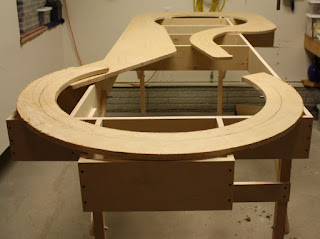I thought I would start with benchwork, since that is where the 3 dimensional idea that is in my head actually begins to take shape. I wrote a fairly comprehensive article about plywood benchwork in my Marias Pass series, so I won't go into that detail here. This is more of an overview of my experience building benchwork, and several examples.
Benchwork Best Practices:
I have used plywood framing for my last two layout structures, and will probably never use anything else. I simply can't accept the warped junk that is found at home improvement stores. Sure you can buy premium lumber, but it is overpriced and too pretty to be hidden by a fascia board. Instead, I buy 3/4" birch or oak veneer plywood, rip it into boards, and make my own lumber. Sure you needs tools to accomplish this, but I happen to be a handy guy, so the tools have more than paid for themselves.
Even though the framing material has changed over the years, the one common thread throughout is the fascia. I continue to use 1/8" masonite for my fascia. It is a great material that cuts easy, bends around modest curves, and provides a very professionally looking edge.
I use a long piece of masonite as a fence for my ripsaw. A steady hand will make perfectly square boards. Once I have a stack of lumber, I then turn to my miter saw to cut the pieces to length.
Here is the benchwork for the Marias Pass layout. The width of the boards for the open frame are a true 6", and probably overkill, but I like solid benchwork. Also, this layout is portable, so needs to resist twisting while being carried and loaded.
Here is a two section frame that I built for a total of 14'. This was intended to become a BNSF Orin Line layout, but instead it was sold to a friend that designed it into a desert themed layout. You can see the 2" foam in the background that was used for the track surface. The frame sections and leg assemblies are all built using plywood.
Here is layout #1 on its side for a photo. I used regular pine lumber with a plywood cookie cutter subroadbed.
The Rocky Mt. Sub had a similar frame design to my first layout. Again using standard pine 1x4's, I built an open grid frame with a plywood cookie cutter subroadbed.
My BNSF Orin Line was the first layout to use plywood for the frame. I am picky when it comes to building materials, and wanted a very straight and sturdy structure since I was going with a 4' x 10' footprint. a sheet of 1/2" plywood was used for the top, in order to provide a rigid surface for track and scenery.
Here is a layout benchwork that I helped a friend build several years ago. The design is nearly identical to the 5'x7' Rio Grande layout that Mike Danneman built. It also used standard pine 1x4's with a plywood cookie cutter subroadbed.





























